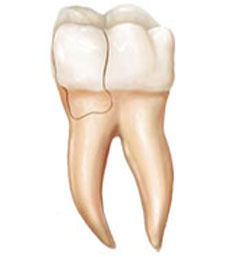Cracked Teeth
Habits such as clenching, grinding, and chewing on hard objects, can lead to the cracking of teeth. A cracked tooth may not show any visible signs of damage and may present with a range of symptoms, such as pain to chewing and sensitivity to heat and cold. In many cases, the pain may come and go, making it difficult to locate the source. Our experience in this area is extensive. With the help of CBCT imaging, we are able to locate the source of a cracked tooth and recommend the appropriate treatment. Below are more detailed explanations on the subject of cracks and cracked teeth.
Why Cracked Teeth Hurt
When the outer layer of the tooth cracks, continued chewing can cause the crack to propagate deeper. Chewing can also create movement of the pieces, which can lead to pain and sensitivity. Eventually, the pulp will become damaged to the point that it can no longer heal itself. If left untreated, extensive cracks can lead to dental infections.
Types of Cracked Teeth
There are many different types of cracked teeth. Treatment depends on the type, location, and extent of the crack.
.jpg) Infraction (Craze Line)
Infraction (Craze Line)
Craze lines, which are commonly seen in adult teeth, are small cracks on the outer enamel portion of the tooth only. Unless for cosmetic reasons, they generally require no treatment as there is no sensitivity associated with them.
Fractured Cusp
Due to repeated forces from chewing and/or clenching, the cusp (or “corner”) of the tooth can crack. If untreated, the crack can eventually cause the cusp to break off. The treatment of choice is usually a crown restoration. If the fracture is deep enough, the pulp may become damaged and root canal treatment is necessary prior to having the crown work done.
Cracked Tooth
This type of crack usually spans from the top (chewing surface) of the tooth and extends towards the root, and sometimes below the gum. The tooth will commonly require root canal treatment followed by a crown to properly restore it to function. If a crack is “too deep”, restoring the tooth would not be possible. In these situations, extraction is recommended. If left untreated, a crack will eventually lead to a split tooth.
Split Tooth
A split tooth is often the result of the long term progression of a cracked tooth. The split tooth is identified by a crack with distinct segments that can be separated. A split tooth cannot be saved intact. The position and extent of the crack, however, will determine whether any portion of the tooth can be saved. In rare instances, endodontic treatment and a crown or other restoration by your dentist may be used to save a portion of the tooth.
Vertical Root Fracture
Vertical root fractures are cracks that begin in the root of the tooth and extend toward the chewing surface. They often show minimal signs and symptoms and may therefore go unnoticed until the surrounding bone and gum become infected. Treatment usually involves the extraction of the tooth. However, endodontic surgery is sometimes appropriate if a portion of the tooth can be saved by the removal of the fractured root.
Horizontal Root Fracture
This type of fracture results from a severe blunt force to a tooth. A 3D image (CBCT), taken during a consultation appointment, will confirm the presence of a horizontal fracture. In most cases, the tooth cannot be restored and extraction is recommended
Preventing Cracked Teeth
While cracked teeth are not completely preventable, you can take some steps to make your teeth less susceptible to cracks.
- Don't chew on hard objects such as ice, unpopped popcorn kernels, etc
- If you clench or grind your teeth, ask your dentist to make you a nightguard
- Wear a mouthguard or protective mask when playing contact sports.





